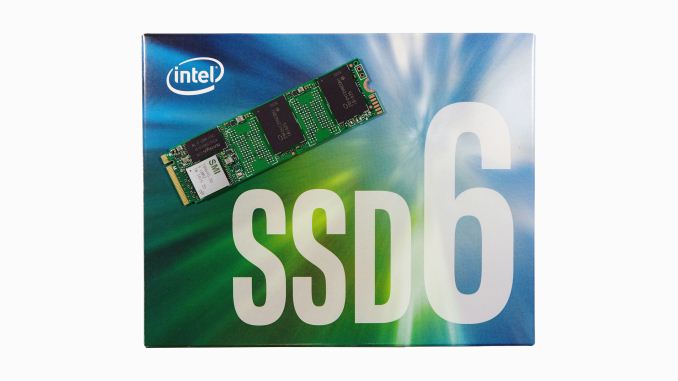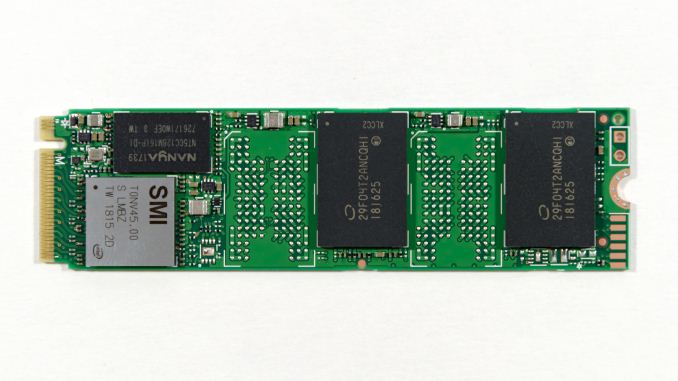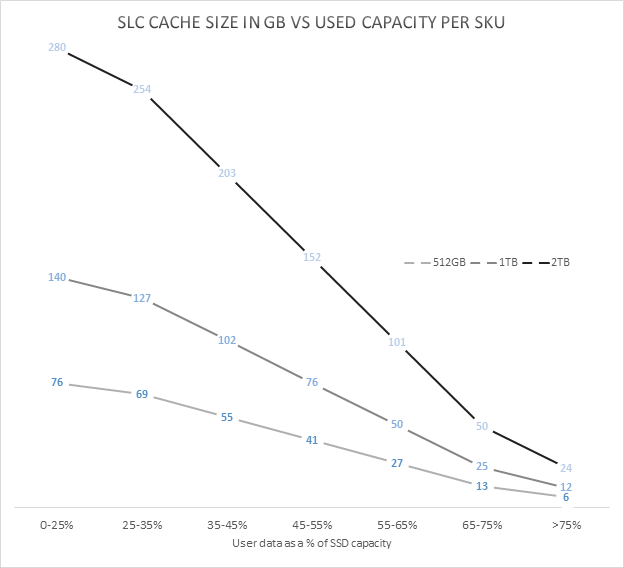512gb Intelã‚â® 660p Series Pcie Nvme M2 Ssd Review

When NAND wink memory was showtime used for full general purpose storage in the earliest ancestors of modern SSDs, the memory cells were treated as but binary, storing a single bit of information per jail cell by switching cells between one of ii voltage states. Since and then need for higher capacity has pushed the industry to store more bits in each flash retentiveness prison cell.
In the past year, the deployment of 64-layer 3D NAND wink has allowed almost all of the SSD industry to adopt three bit per cell TLC flash, which only a few brusque years ago was the cutting edge. At present, iv chip per cell, also known as Quad-Level Cell (QLC) NAND flash, is the current frontier.
Each transition to storing more than bits per memory cell comes with significant downsides that offset the entreatment of higher storage density. The 4 $.25 per cell storage style of QLC requires discriminating between 16 voltage levels in a flash memory jail cell. The process of reading and writing with adequate precision is unavoidably slower than accessing NAND flash that stores fewer bits per prison cell. The mistake rates are higher, so QLC-capable SSD controllers need very robust error correction capabilities. Information retention and write endurance are reduced.
But QLC NAND is entering a market where TLC NAND can provide more performance and endurance than most consumers really need. QLC NAND doesn't introduce any fundamentally new problems, it just is affected more severely with the challenges that have already been overcome by TLC NAND. The same strategies that are in widespread use to mitigate the downsides of TLC NAND are also usable for QLC NAND, but QLC will always exist the cheaper lower-quality alternative to TLC NAND.
On the commercial product forepart, Micron introduced an enterprise SATA SSD with QLC NAND this spring, and anybody else is working on QLC NAND as well. Only for consumers, where the pricing advantages of QLC are going to exist the most noticed, it is Intel who the first to market with a consumer SSD that uses QLC NAND wink memory. Today the company is taking the wraps off of their new Intel SSD 660p, an entry-level M.2 NVMe SSD with upward to 2TB of QLC NAND.
Intel has reportedly cut off farther development of consumer SATA drives, and so naturally their first consumer QLC SSD is a member of their half-dozen-series, the lowest tier of NVMe SSDs. The 660p comes as a replacement for the Intel SSD 600p, Intel's first M.two NVMe SSD and one of the beginning consumer NVMe drives that aimed to be cheaper and slower than the premium loftier-end NVMe SSDs, through the utilize of TLC NAND at a fourth dimension when NVMe SSDs were however primarily using MLC NAND. The purpose of the Intel 660p is to push prices down even further while notwithstanding providing better performance than SATA SSDs or the 600p.
| Intel SSD 660p Specifications | |||||
| Capacity | 512 GB | ane TB | 2 TB | ||
| Controller | Silicon Motion SM2263 | ||||
| NAND Flash | Intel 64L 1024Gb 3D QLC | ||||
| Form-Factor, Interface | single-sided M.two-2280, PCIe 3.0 x4, NVMe i.3 | ||||
| DRAM | 256 MB DDR3 | ||||
| Sequential Read | up to 1800 MB/due south | ||||
| Sequential Write (SLC cache) | up to 1800 MB/due south | ||||
| Random Read (4kB) | up to 220k IOPS | ||||
| Random Write (4kB, SLC enshroud) | upward to 220k IOPS | ||||
| Warranty | five years | ||||
| Write Endurance | 100 TB 0.1 DWPD | 200 TB 0.i DWPD | 400 TB 0.i DWPD | ||
| SLC Write Cache | Minimum | 6 GB | 12 GB | 24 GB | |
| Maximum | 76 GB | 140 GB | 280 GB | ||
| MSRP | $99.99 (20¢/GB) | $199.99 (xx¢/GB) | TBD | ||
Looking under the hood, Intel's partnership with Silicon Motion for client and consumer SSDs continues with the use of the SM2263 NVMe SSD controller for the 660p. This is the smaller 4-aqueduct sibling to the SM2262 and SM2262EN controllers that are doing very well in the more high-cease parts of the SSD market. A iv-channel controller makes sense for a QLC drive, because the big 1Tb (128GB) per-die chapters of Intel's 64-layer 3D QLC NAND means it only takes a few chips to reach mainstream bulldoze capacities.
The 660p lineup starts at 512GB (four QLC dies) and scales up to 2TB. All three capacities are single-sided M.2 2280 cards with a constant 256MB of DRAM. Mainstream SSDs typically utilize ane GB of DRAM per 1TB of wink, and then the 660p is rather brusk on DRAM even at the 512GB capacity. Equally a cost-oriented SSD it might make sense to use the DRAMless SM2263XT controller and the NVMe Host Retention Buffer characteristic, but that significantly complicates firmware development and error treatment. The small size of the SM2263 controller allows Intel to fit all four NAND packages used by the 2TB model on ane side of the PCB.

Intel doesn't break down operation specs for the 660p by drive capacity, and the read and write operation ratings are the same, thanks to the acceleration of SLC write caching. Intel doesn't provide whatever official spec for write operation after the SLC cache is filled, but we've measured about 100 MB/s on our 1TB sample. This steady-state sequential write speed will vary with drive capacity. Intel is offering a v year warranty on the drive and write endurance is about 0.1 drive writes per twenty-four hour period, lower than the 0.iii DWPD typical of mainstream consumer SSDs, but something that should still adequate for most users.
Probably the most important aspect of a consumer QLC drive pattern is the beliefs of the SLC cache. Consumer TLC drives universally treat a portion of their NAND flash memory every bit pseudo-SLC, using that higher-performing memory segment as a write cache. QLC SSDs are even more reliant on SLC caching considering the performance of raw QLC NAND is even lower than that of TLC.
No SLC caching strategy tin can perfectly accelerate every workload and use case, and there are meaning tradeoffs betwixt different strategies. The Intel SSD 660p employs a variable-size SLC cache, and all data written goes commencement to the SLC cache before being compacted and folded into QLC blocks. This means that the steady-state 100MB/s sequential write speed we've measured is significantly below what the drive could deliver if the writes went straight to the QLC without the extra SLC to QLC copying step getting in the style. When the drive is by and large empty, upwardly to about half of the bachelor flash memory cells volition be treated as SLC NAND. As the bulldoze fills upward, blocks will exist converted to QLC usage, shrinking the size of the cache and making it more probable that a real-world utilise instance could write plenty to make full that enshroud.

Our electric current test suite cannot fully capture the dynamics of a variable-size SLC cache, and we haven't had the 660p in mitt long plenty to thoroughly test it at various states of fill. When the Intel SSD 660p is more often than not empty and the SLC enshroud size is huge, many of our standard benchmarks end up testing primarily the performance of the SLC cache — and for reads in improver to writes, because in these weather the 660p isn't very aggressive about moving data from SLC blocks to QLC. As a upshot, our synthetic benchmark tests take been run both with our standard methodology, and with a completely full drive then that the tests measure out performance of the QLC memory (with an SLC cache that is too small to entirely comprise any of our tests). The two sets of scores thus represent the two extremes of functioning that the Intel SSD 660p tin can deliver. The total-drive results in this review represent a worst-case scenario that will almost never be encountered by existent-earth usage, because our tests give the drive limited idle time to flush the SLC cache but in the real world consumer workloads nearly ever requite SSDs far more than idle time than they demand.
Intel's initial pricing for the 660p works out to just under twenty¢/GB, putting it very close to the street prices of the cheapest current-generation TLC-based SSDs. The Intel SSD 660p goes on auction today, and is being showcased by Intel at Wink Retentivity Tiptop this week. In traveling to FMS, I left behind a testbed full of drives running extra benchmarks for this review. When I can grab a break from all the news and activities at FMS, I will be calculation to this review.
The Contest
The Intel SSD 660p is positioned equally a very cheap entry-level NVMe SSD, so our chief focus is on comparison it against other depression-end NVMe drives and against SATA drives. Every bit usual, the Crucial MX500 serves as our representative of mainstream SATA SSDs thanks to its consistently good pricing and solid all-effectually performance. The other depression-finish NVMe SSDs in this review are the 660p'south predecessor Intel SSD 600p, the Phison E8-based Kingston A1000 and and the Toshiba RC100 DRAMless NVMe SSD that uses the Host Memory Buffer feature.
| AnandTech 2018 Consumer SSD Testbed | |
| CPU | Intel Xeon E3 1240 v5 |
| Motherboard | ASRock Fatal1ty E3V5 Performance Gaming/OC |
| Chipset | Intel C232 |
| Memory | 4x 8GB G.SKILL Ripjaws DDR4-2400 CL15 |
| Graphics | AMD Radeon Hard disk 5450, 1920x1200@60Hz |
| Software | Windows x x64, version 1709 |
| Linux kernel version iv.14, fio version 3.six | |
| Spectre/Meltdown microcode and OS patches current every bit of May 2018 | |
- Thanks to Intel for the Xeon E3 1240 v5 CPU
- Thanks to ASRock for the E3V5 Functioning Gaming/OC
- Cheers to 1000.SKILL for the Ripjaws DDR4-2400 RAM
- Thanks to Corsair for the RM750 ability supply, Carbide 200R example, and Hydro H60 CPU cooler
- Thanks to Quarch for the XLC Programmable Power Module and accessories
- Thank you to StarTech for providing a RK2236BKF 22U rack cabinet.
AnandTech Storage Bench - The Destroyer
Source: https://www.anandtech.com/show/13078/the-intel-ssd-660p-ssd-review-qlc-nand-arrives
0 Response to "512gb Intelã‚â® 660p Series Pcie Nvme M2 Ssd Review"
Post a Comment